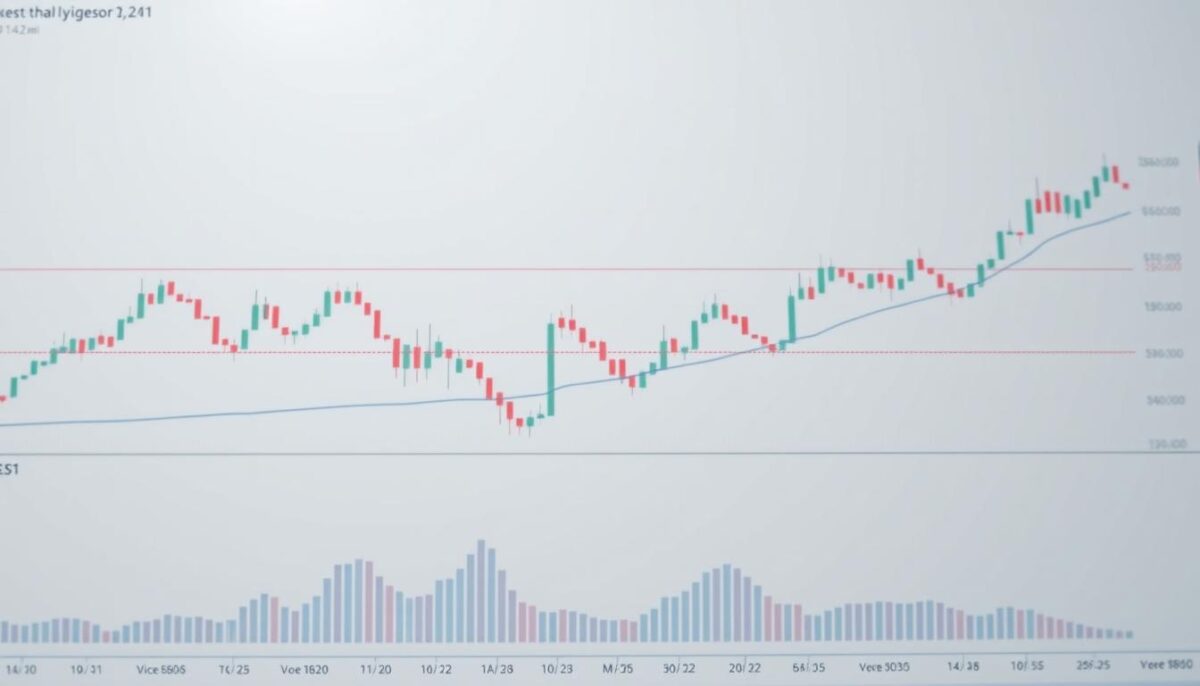Trading is more than just numbers; it’s a journey of self-discovery. Every chart and trade is a chance to learn about yourself and the financial world. To master stock trading, start by always learning and improving yourself.
To boost your trading skills, you need to be resilient and strategic. Successful traders aren’t born; they’re made through hard work, understanding the market, and a strong desire to grow.
This guide will show you the key skills and methods that set top traders apart. You’ll learn how to handle market ups and downs, make smart choices, and build a strong trading plan that can face any economic test.
Table of Contents
Essential Trading Skills for Market Success
Trading is complex, and having the right skills is key. Successful traders do more than just look at charts. They can quickly understand market data and stay focused. This helps them make money consistently and avoid big losses.

Learning to control your emotions is the first step. It starts with building a strong foundation. This foundation helps you make smart choices, even when it’s hard.
Analytical Abilities and Data Interpretation
Traders need to be good at analyzing data. They must turn raw data into useful information. This includes:
- Identifying key market trends
- Recognizing complex chart patterns
- Understanding statistical correlations
- Evaluating economic indicators
Research and Information Processing
Good market research is systematic. Here are ways to improve your skills:
- Create a structured research routine
- Use multiple reliable information sources
- Develop a personal news and data tracking system
- Learn to filter and prioritize market information
Focus and Concentration Development
Trading requires mental toughness. Here are ways to improve your focus:
| Technique | Benefit |
|---|---|
| Meditation | Improves mental clarity |
| Regular exercise | Increases mental stamina |
| Structured daily routine | Reduces decision fatigue |
| Mindfulness practices | Enhances emotional control |
Keep working on these skills to succeed in trading. Remember, learning technical analysis and trading psychology is a journey. It’s all about getting better every day.
Understanding Market Psychology and Emotional Control

Mastering trading psychology is key for investors. Your emotions can greatly affect your financial choices. This can lead to either big wins or big losses. It’s vital to understand and manage your emotional triggers in the market.
Traders often face psychological hurdles that can throw off their plans. The main emotional barriers include:
- Fear of losing money
- Greed-driven impulsive decisions
- Overconfidence after successful trades
- Anxiety during market volatility
Good risk management helps keep emotions in check. Successful traders use strategies to control their feelings:
- Create a structured trading plan
- Set predefined entry and exit points
- Practice disciplined capital allocation
- Use stop-loss mechanisms
Emotional intelligence is crucial for trading success. Knowing your emotional patterns helps you stay strong and make better choices.
| Emotional State | Trading Impact | Recommended Strategy |
|---|---|---|
| Fear | Missed opportunities | Systematic risk assessment |
| Greed | Excessive risk-taking | Strict position sizing |
| Overconfidence | Ignoring warning signals | Regular performance review |
Mastering trading psychology turns emotional challenges into strengths. By staying aware and disciplined, you can improve your trading skills.
Technical Analysis Fundamentals for Traders
Learning technical analysis is key for trading success. It lets you understand market trends and price movements. This knowledge is crucial for making smart trading choices.

Professional traders use advanced methods to analyze markets. These strategies help spot trading chances and reduce risks.
Chart Pattern Recognition
Chart patterns show what traders think. Knowing these patterns can give you a big advantage:
- Head and shoulders pattern
- Double tops and bottoms
- Triangular formations
- Wedge patterns
Indicator Analysis and Implementation
Technical analysis uses indicators to check market conditions. Important indicators include:
- Moving averages
- Relative Strength Index (RSI)
- Moving Average Convergence Divergence (MACD)
- Stochastic oscillator
Price Action Trading Techniques
Price action trading looks at price changes alone. It helps you grasp market mood by studying:
- Candlestick patterns
- Support and resistance levels
- Trend lines
- Trading volume
Successful traders see technical analysis as a skill that needs constant learning and practice.
Getting good at these technical analysis methods will change how you trade. It will help you make better and more confident investment choices.
Risk Management Strategies and Capital Preservation
Keeping your trading capital safe is key to long-term success. Good risk management is essential in the competitive trading world. Without a solid plan, you could lose all your hard-earned money.
Traders who succeed know that diversifying their portfolios is more than just a backup plan. It’s a vital way to handle potential losses and increase gains in different market conditions.
- Limit risk on individual trades to 1-2% of total account balance
- Use stop-loss orders to protect against significant downturns
- Spread investments across multiple asset classes
- Regularly review and rebalance your portfolio
Your risk management strategy should be as detailed as your trading plan. Professional traders use advanced methods to reduce losses and stay open to market chances.
| Risk Management Technique | Key Benefit | Implementation |
|---|---|---|
| Position Sizing | Limits potential losses | Calculate trade size based on account balance |
| Stop-Loss Orders | Automatic loss protection | Set predetermined exit points |
| Portfolio Diversification | Reduces overall risk exposure | Invest across different markets and assets |
“The first rule of trading is to preserve capital. The second rule is to remember the first rule.” – Unknown Trader
By using strong risk management, you turn trading into a strategic way to grow wealth. Your ability to keep your capital safe will decide your long-term success in the markets.
Rocket Your Trading Skills Through Professional Development
Continuing trader education is key to trading success. It turns new traders into market pros by offering a clear path for skill and knowledge growth.
Traders who keep learning can boost their skills way beyond what they thought possible. The market favors those who grow personally and stay flexible with financial changes.
Building a Strong Knowledge Foundation
Building a solid knowledge base needs smart learning strategies:
- Study fundamental market economics
- Analyze historical trading patterns
- Read financial publications regularly
- Attend professional trading workshops
Implementing Advanced Trading Techniques
Getting better at trading means learning complex strategies:
| Technique | Skill Level | Learning Difficulty |
|---|---|---|
| Algorithmic Trading | Advanced | High |
| Options Strategy | Intermediate | Medium |
| Trend Analysis | Beginner | Low |
Developing Your Trading Style
“Success in trading comes from understanding yourself as much as understanding the market.” – Professional Trader
Your trading style grows from constant practice, self-reflection, and focused learning. Use your strengths and work on your weaknesses with ongoing trader education.
Market Trend Analysis and Pattern Recognition
Understanding market trends is key for trading success. Technical analysis gives traders tools to grasp price movements. This knowledge helps make better trading decisions.
Learning to spot market trends can boost your trading strategy and profits.
Market trend analysis starts with knowing three main trend types:
- Uptrend: Prices go up consistently
- Downtrend: Prices go down consistently
- Sideways trend: Prices stay in a horizontal range
When analyzing market trends, focus on important technical analysis tools. These tools help spot trend strength and possible reversals. They include:
- Identifying support and resistance levels
- Using moving average crossover signals
- Volume analysis for trend confirmation
- Recognizing candlestick patterns
Professional traders use many indicators to check market trends. By mixing different technical analysis tools, you can create a stronger trend identification method. This might mean using moving averages with momentum indicators to check trend direction and find entry points.
“Successful trend analysis requires patience, practice, and a systematic approach to market observation.” – Professional Trading Mentor
Keep in mind, no single method can predict trends perfectly. Your aim is to understand market dynamics well. Then, create a flexible trading strategy that adjusts to market changes.
Advanced Order Execution and Position Management
Mastering order execution tactics is key for trading success. Professional traders know that precise position management is vital. It can mean the difference between making profits and making mistakes.
Effective trading needs a full approach to managing positions. Traders must use advanced techniques to protect their capital and increase returns.
Entry and Exit Strategies
- Identify clear entry points based on technical indicators
- Use limit orders to control precise entry prices
- Implement trailing stop-loss techniques
- Create predefined exit criteria for both winning and losing trades
Position Sizing Techniques
Risk management starts with smart position sizing. Your aim is to protect your capital while keeping room for market chances.
- Calculate maximum risk per trade (typically 1-2% of total capital)
- Adjust position sizes based on market volatility
- Use percentage-based position sizing methods
- Implement dynamic sizing strategies
Trade Management Best Practices
Successful traders follow disciplined trade management. This means constant monitoring, making strategic changes, and keeping emotions in check.
Professional traders never risk more than they can afford to lose and always prioritize capital preservation.
By combining advanced order execution with solid risk management, you’ll lay a strong foundation for trading success. Remember, mastering these skills takes practice, patience, and ongoing learning.
Trading Tools and Technology Mastery
In the fast-paced world of trading, mastering cutting-edge technology is key. It gives you a big advantage over others. Success comes from using powerful tools and advanced techniques to make quick decisions.
Today’s traders have many technological tools at their disposal. These tools can change how they trade. It’s important to pick the right platforms and tools for a strong trading strategy.
- MetaTrader 5 for advanced charting and real-time market data
- TradingView for collaborative analysis and social trading insights
- Thinkorswim for comprehensive options trading capabilities
- Forex Tester for strategy validation and historical backtesting
“Technology is the great equalizer in trading. The right tools can help you make more informed decisions faster than ever before.” – Professional Trader
Trading automation tools have changed how traders work. These tools let you use complex techniques with great accuracy. They help you test and refine strategies fast, making your trading more consistent.
| Tool Category | Key Features | Best For |
|---|---|---|
| Charting Software | Advanced technical indicators, custom drawing tools | Technical analysis and pattern recognition |
| Automation Tools | Algorithmic strategy development, backtesting | Systematic trading and strategy optimization |
| Market Analysis Platforms | Real-time data, social trading insights | Comprehensive market research |
Your success in trading depends on keeping your tools up to date. Always learn about new tools and techniques. This will help you stay ahead in the fast-changing financial markets.
Building a Sustainable Trading Career
Turning your love for stock trading into a lasting career needs careful planning. It’s not just about making money. It’s about building a strong career foundation for long-term success.
To succeed in trading, you need more than just market knowledge. You must blend technical skills, emotional smarts, and smart portfolio diversification strategies.
Creating Your Trading Business Plan
A detailed trading business plan is your career guide. It should outline:
- Clear trading goals
- Strong risk management plans
- How you’ll manage your money
- How you’ll measure your success
Setting Realistic Goals and Milestones
Reaching success in trading means setting reachable goals. Break down your big dreams into smaller, doable steps for each quarter and year. These goals should push you but also keep you motivated.
- Set short-term goals you can hit
- Plan for regular learning
- Set financial targets
- Check and tweak your goals every quarter
Performance Tracking and Analysis
Improving is key in trading. Keep a detailed journal of your trades. Record not just the money you make or lose, but also your thought process, emotions, and what you learn.
Trading is a skill that gets better with regular self-reflection and smart adjustments.
Staying committed to learning and growing will set you apart in the competitive trading world. View your trading career as a serious business. Invest in your skills and stay open to market changes.
Developing a Winning Trading Mindset
Trading psychology is key to success in the markets. Your mindset can either make or break your trading career. Learning to control your emotions is as important as knowing the technical side of trading.
Successful traders know that emotions can lead to bad decisions. To win, you need discipline and to know yourself well. You should:
- Recognize and manage emotional triggers
- Maintain objective analysis during market volatility
- Transform losses into learning opportunities
- Stay consistent with your trading strategy
Being resilient is what sets pros apart from beginners. Controlling your impulses and making smart choices under pressure is crucial. Viewing each trade as a chance to grow, not just a gamble, is part of mastering trading psychology.
“The market is a device for transferring money from the impatient to the patient.” – Warren Buffett
Having a growth mindset is essential in trading. See challenges as ways to get better. Keep track of your progress and always look for ways to improve. Keep learning and managing your emotions to boost your trading skills.
Try mindfulness, keep a trading journal, and stick to routines that help you make smart choices. Your mental game is your biggest advantage in the markets.
Conclusion
Your journey into trading is a path of learning and growth. To improve your trading skills, you need dedication and strategic thinking. The strategies in this article are a solid start for your trading career.
Getting better at trading is essential in today’s fast-changing markets. Every trading session brings new challenges and chances. Your ability to adapt and learn will shape your success.
The path to becoming a skilled trader is not easy. You will face setbacks and learn from mistakes. These experiences are key to your growth.
Keep using the strategies you’ve learned, track your progress, and stay focused on your goals. Your future in trading depends on your willingness to learn and grow. Start now and watch your skills improve.







